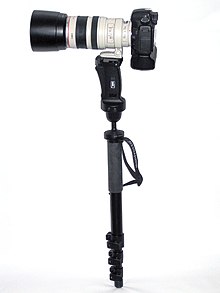Monopod
A monopod (also monopod , from ancient Greek μόνος monos 'single' and πούς pous 'foot') is a transportable tripod for a better hold of the recording devices (such as photo or video cameras ) and has - in contrast to the widely used tripods - only one leg. The leg is mostly made with telescopic tubes so that it can be adjusted quickly but also be transported to save space.
The monopod enables longer exposure times by serving as a “holding aid” for the recording device in poor light conditions. "Holding aid" because it does not stand alone, but is held by the user. It is also often used when using long focal lengths.
The monopod is usually supported on the floor. However, there is also the option of supporting it in a shortened length on a table, chair, etc., on the hip or in a jacket pocket.
It reduces the risk of unwanted blurring when taking pictures with a longer exposure time, it is lighter and more compact than the tripod, fits more into a photo bag and is particularly useful in poor lighting conditions.
The rule of thumb for sharp images in freehand photography is that the exposure time in seconds should be shorter than the reciprocal of the 35mm-equivalent focal length used in millimeters. Example: If a lens with a focal length of 90 mm is used, an exposure time longer than 1/90 of a second should not be used if sharp images are to be taken. A monopod can be helpful here to achieve blur-free recordings even in darker lighting conditions. A tripod is indispensable for long exposure times (no later than seconds).
Use as a steadycam
With modern, lightweight camcorders , it is often difficult to film scenes by hand, despite image stabilization . Recordings while running are often unusable. The monopod can be used here as an inexpensive and at the same time relatively light alternative to a steadycam . For this purpose, the (partially) pushed together tripod is mounted on the camera and held at or slightly above the common center of gravity while filming. Even recordings while walking appear as if the camera is “floating”.
The hanging coupling of the tripod leg, which is long compared to the camera, greatly increases the moments of inertia around the two horizontal axes. As typically only one hand guides the tripod, turning the shoulder belt hardly leads to twisting of the camera. Conversely, a swivel can easily be made by rolling the tripod leg between thumb and fingers or from the wrist joint.
Use as a tool for selfies
When held upwards, the light version of the tripod in connection with a smartphone or a light camera allows selfies to be taken even in the crowd of sights. These then serve as a background. The reach of the arm is extended, thus increasing the height. This means that group pictures are also possible. The prerequisite for this is that the optical axis can be tilted from 90 ° to around 30 ° towards the stand base via a ball or hinge joint.
advantages
You can change location and turn the camera faster than with a tripod. Therefore monopods are mainly used for sports and action photography. Monopods are often used at conferences, parties or other events with professional photographers. In contrast to tripods, monopods are usually allowed in museums (because of the lower risk of accidents for passers-by).
The often not insignificant weight of cameras with telephoto lenses is supported on the ground with a monopod and therefore does not have to be held free-hand; this enables long, fatigue-free work. A one-legged tripod standing on the floor also supports the camera against tilting, especially with a long lens forwards. If the camera is mainly photographed in approximately horizontal directions, you do not need a tripod joint, as lateral pans can be made with the tripod leg.
Other areas of application
- Support for a rifle in "hands-free" shooting. Indispensable for (historical) shooting with the musket ("fork stick", "shooting stick").
- Support for binoculars (including double glasses) with higher magnification.
- When using a bearing compass (the monopod must be anti-magnetic for this).
disadvantage
With monopods it is not possible to take pictures without shaking to the same extent as with a tripod. With the monopod mounted, the camera can hardly be put down; Separating the camera from the tripod is often essential, so a tripod head with a quick release plate is highly recommended. A monopod without a ball head has to be tilted sharply upwards or downwards for panning and thus quickly gets out of balance. Portrait shots are only possible with a suitable tripod head or a lens clamp.
Ideally, each tripod couples under the center of gravity of the camera-lens unit. Long, heavy lenses therefore typically have their own tripod connection (which can be rotated quickly around the optical axis for portrait format shots). To the extent that the tripod supports the camera outside of the center of gravity, the resulting tilting moment bends the tripod leg, which can lead to suspension oscillations around the lateral axis of the camera when it is first placed on the ground.
Trivia
Some users use a plate (often covered with felt) on a monopod instead of a tripod head in order to quickly move the camera from landscape to portrait format or to use it "unleashed". It has also proven its worth when used as a rifle support and support for binoculars.
